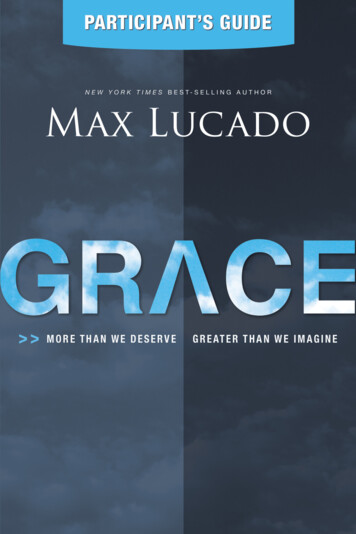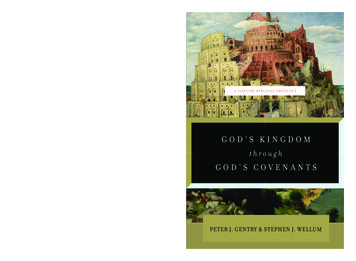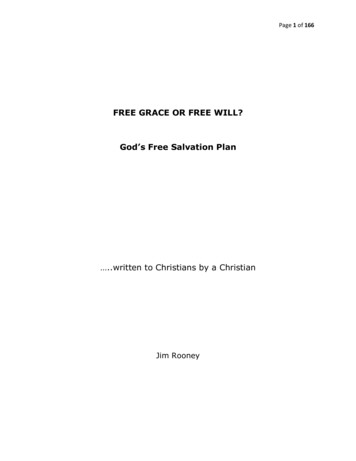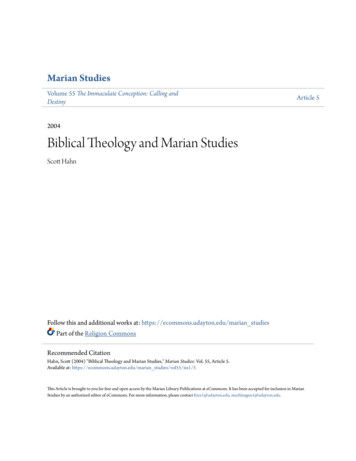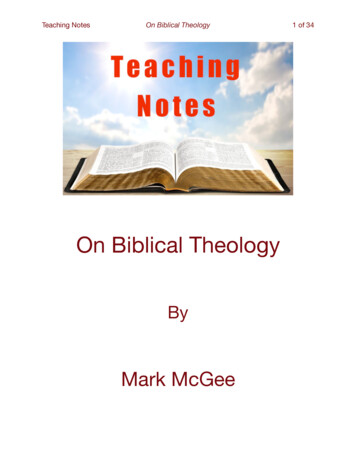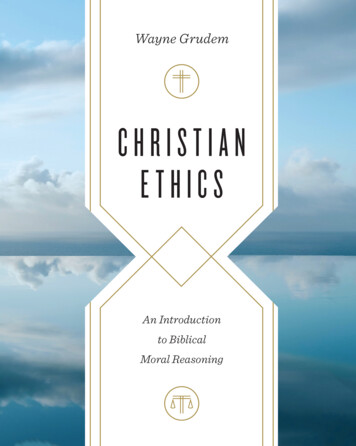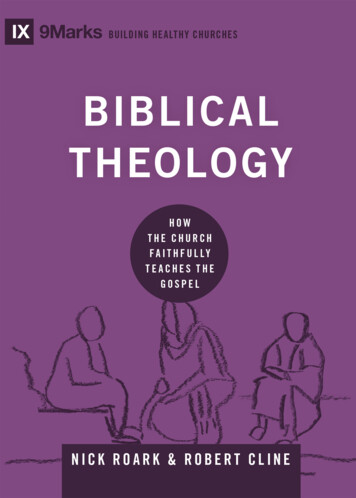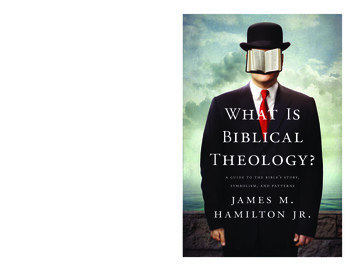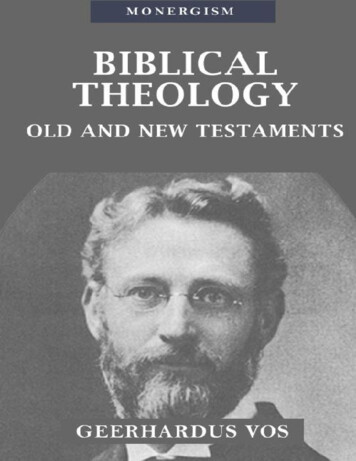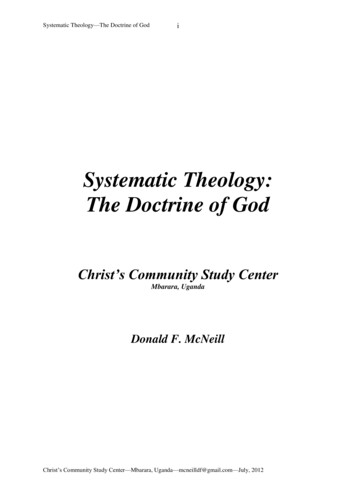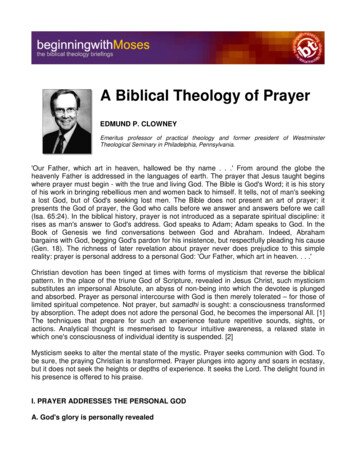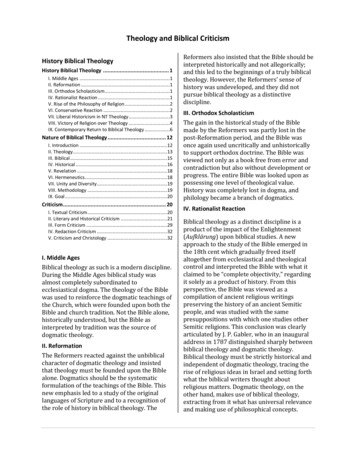
Transcription
Theology and Biblical CriticismHistory Biblical TheologyHistory Biblical Theology . 1I. Middle Ages .1II. Reformation .1III. Orthodox Scholasticism .1IV. Rationalist Reaction .1V. Rise of the Philosophy of Religion .2VI. Conservative Reaction .2VII. Liberal Historicism in NT Theology .3VIII. Victory of Religion over Theology .4IX. Contemporary Return to Biblical Theology .6Nature of Biblical Theology . 12I. Introduction .12II. Theology .13III. Biblical .15IV. Historical .16V. Revelation .18VI. Hermeneutics .18VII. Unity and Diversity .19VIII. Methodology .19IX. Goal .20Criticism . 20I. Textual Criticism .20II. Literary and Historical Criticism .21III. Form Criticism .29IV. Redaction Criticism .32V. Criticism and Christology .32I. Middle AgesBiblical theology as such is a modern discipline.During the Middle Ages biblical study wasalmost completely subordinated toecclesiastical dogma. The theology of the Biblewas used to reinforce the dogmatic teachings ofthe Church, which were founded upon both theBible and church tradition. Not the Bible alone,historically understood, but the Bible asinterpreted by tradition was the source ofdogmatic theology.II. ReformationThe Reformers reacted against the unbiblicalcharacter of dogmatic theology and insistedthat theology must be founded upon the Biblealone. Dogmatics should be the systematicformulation of the teachings of the Bible. Thisnew emphasis led to a study of the originallanguages of Scripture and to a recognition ofthe role of history in biblical theology. TheReformers also insisted that the Bible should beinterpreted historically and not allegorically;and this led to the beginnings of a truly biblicaltheology. However, the Reformers’ sense ofhistory was undeveloped, and they did notpursue biblical theology as a distinctivediscipline.III. Orthodox ScholasticismThe gain in the historical study of the Biblemade by the Reformers was partly lost in thepost-Reformation period, and the Bible wasonce again used uncritically and unhistoricallyto support orthodox doctrine. The Bible wasviewed not only as a book free from error andcontradiction but also without development orprogress. The entire Bible was looked upon aspossessing one level of theological value.History was completely lost in dogma, andphilology became a branch of dogmatics.IV. Rationalist ReactionBiblical theology as a distinct discipline is aproduct of the impact of the Enlightenment(Aufklärung) upon biblical studies. A newapproach to the study of the Bible emerged inthe 18th cent which gradually freed itselfaltogether from ecclesiastical and theologicalcontrol and interpreted the Bible with what itclaimed to be “complete objectivity,” regardingit solely as a product of history. From thisperspective, the Bible was viewed as acompilation of ancient religious writingspreserving the history of an ancient Semiticpeople, and was studied with the samepresuppositions with which one studies otherSemitic religions. This conclusion was clearlyarticulated by J. P. Gabler, who in an inauguraladdress in 1787 distinguished sharply betweenbiblical theology and dogmatic theology.Biblical theology must be strictly historical andindependent of dogmatic theology, tracing therise of religious ideas in Israel and setting forthwhat the biblical writers thought aboutreligious matters. Dogmatic theology, on theother hand, makes use of biblical theology,extracting from it what has universal relevanceand making use of philosophical concepts.
Theology and Biblical CriticismDogmatic theology is that which a particulartheologian decides about divine matters,considered philosophically and rationally inaccordance with the outlook and demands ofhis own age; but biblical theology is concernedsolely with what men believed long ago.Gabler was essentially a rationalist, and hisapproach to biblical theology prevailed forsome fifty years. Works on the theology of theBible were written by Kaiser (1813), De Wette(1813), Baumgarten-Crusius (1828), and vonCölln (1836). Some scholars of this period wereextremely rationalistic, finding in the Biblereligious ideas that were in accord with theuniversal laws of reason. Others tried toreconcile Christian theology with the thoughtforms of the modern period. While thisrationalistic perspective as such is long sincepassé, it is obvious that this historical approachto the study of the Bible is still the fundamentalassumption of modern scholarship; and evenEvangelical scholars employ the historicalmethod, although with limitations.V. Rise of the Philosophy of ReligionRationalism was superseded under theinfluence of the idealist philosophy of Hegel (d.1813), who saw the Absolute Idea or AbsoluteSpirit eternally manifesting itself in theuniverse and in human affairs. Hegel taughtthat the movement of human thought followedthe dialectic pattern from a position (thesis) toan opposite position (antithesis), from whichinteraction emerged a new insight or aspect ofreality (synthesis). Hegel saw in the history ofreligion the evolution of spirit in its dialecticalapprehension of the divine, from naturereligions, through religions of spiritualindividuality, to the Absolute Religion, which isChristianity.Under the influence of Hegel, Vatke wrote abiblical theology in 1835 in which the emergingcritical views about the OT were combined withHegel’s evolutionary philosophy. Hisinterpretation of the history of Israel’s religionwas much in advance of his day and was passed2over for some thirty years until it was taken upand popularized by Wellhausen.Under the influence of Hegel, F. C. Baurabandoned the rationalistic effort to findtimeless truth in the NT, and instead found inthe historical movements in the early Churchthe unfolding of wisdom and spirit. Theteachings of Jesus formed the point ofdeparture. Jesus’ teachings were not yettheology but the expression of his religiousconsciousness. Theological reflection beganover the question of the law. Paul, the firsttheologian, took the position that the Christianwas freed from the law (thesis). JewishChristianity, represented particularly by Jamesand Peter, took the opposite position, that thelaw was permanently valid and must remain anessential element in the Christian Church(antithesis). Baur interpreted the history ofapostolic Christianity in terms of this conflictbetween Pauline and Judaistic Christianity. Outof the conflict emerged in the 2nd cent the OldCatholic Church, which effected a successfulharmonization between these two positions(synthesis).Baur was less concerned with the truth of theScriptures than with the effort to tracehistorical development. He has made a lastingcontribution, for the principle that biblicaltheology is rooted in history is sound, eventhough Baur’s application of this principle isnot. Baur’s interpretation gave rise to the socalled Tübingen school, which had greatinfluence in German NT studies.VI. Conservative ReactionThese new approaches to the study of the Biblenaturally met with a strong resistance inorthodox circles, not only from those whodenied the validity of a historical approach butalso from those who tried to combine thehistorical approach with a belief in revelation.Influential was E. W. Hengstenberg’sChristology of the OT (Engtr 1829–1835) andHistory of the Kingdom of God under the OT(Engtr 1869–1871). Hengstenberg saw littleprogress in revelation, made little distinction
Theology and Biblical Criticismbetween the two Testaments, and interpretedthe prophets spiritually with little reference tohistory. A more historical approach wasstructured by J. C. K. Hofmann in a series ofwritings beginning in 1841 (Verheissung undErfüllung), in which he attempted to vindicatethe authority and inspiration of the Bible byhistorical means, developing his Heilsgeschichtetheology. Hofmann found in the Bible record ofthe process of holy or saving-history, whichaims at the redemption of all mankind. Thisprocess will not be completed until theeschatological consummation. He tried toassign every book of the Bible to its place in thisscheme of the history of redemption. This socalled Erlangen school (including also J. A.Bengel, J. T. Beck), did not regard the Bibleprimarily as a collection of proof texts or arepository of doctrine but as the witness towhat God had done in saving-history. They heldthat the propositional statements in Scripturewere not meant to be an end in themselves noran object of faith, but were designed to bearwitness to the redemptive acts of God.The most important product of theconservative reaction for this discipline was G.F. Oehler’s Theologie des AT (Prolegomena1845, Theologie 1873; Engtr 1883).Conservative in his critical views and holding tothe revealed character of OT religion, Oehleralso recognized that OT theology is a historicaldiscipline which must describe the OT faith as aphenomenon in history. He criticized the olderview, which limited theological exposition tothe didactic contents of the Bible, insisting thatthe discipline must “exhibit properly theinternal connection of the doctrine ofRevelation with the revealing history” (p. 6).Thus he found the OT to be mediated through aseries of divine acts and commands, and alsothrough the institutions of a divine state. Acondensation of Oehler’s large work was madeby R. F. Weidner (1896). Other conservative OTscholars were Baumgarten, C. A. Auberlen, andthe commentator Franz Delitzsch.The Erlangen school had great influence inconservative circles upon such scholars asTholuck, T. Zahn, P. Feine, and is represented in3the theologies of F. Büchsel (1937), A. Schlatter(1909), and Ethelbert Stauffer (1941; Engtr1955). Stauffer rejects the “systems of doctrine”approach and does not try to trace thedevelopment of the Christian understanding ofthe person and work of Jesus. Rather, hepresents a “Christocentric theology of Historyin the NT,” i.e., the theology of the plan ofsalvation enacted in NT history. The book doesnot distinguish between canonical andnoncanonical writings and ignores the varietyof the several interpretations of the meaning ofChrist in the NT.A new form of the Heilsgeschichte theology hasemerged in recent years, for there is awidespread recognition that revelation hasoccurred in redemptive history and thatHeilsgeschichte is the best key to understandthe unity of the Bible. This will be developedlater.VII. Liberal Historicism in NT TheologyBultmann has pointed out that the logicalconsequence of Baur’s method would havebeen a complete relativism (NT Theology, II[1955], 245), for the liberal mind could notconceive of absolute truth in the relativities ofhistory. Under the influence of Ritschliantheology, the essence of Christianity wasinterpreted as a pure spiritual-ethical religionwhich was proclaimed by and embodied in thelife and mission of Jesus. The kingdom of God isthe highest good, the ethical ideal. The heart ofreligion is personal fellowship with God asFather.This theological interpretation was reinforcedby the solution of the Synoptic problem, with itsdiscovery of the priority of Mark and thehypothetical document Q. Scholars of this “oldliberalism” believed that in these mostprimitive documents historical science had atlast discovered the true Jesus, freed from alltheological interpretation. Biblical theologiansof this school began with this “historical”picture of the ethical religion of Jesus and thentraced the diverse systems of doctrine(Lehrbegriffe) that emerged as the result of
Theology and Biblical Criticismlater reflection and speculation. The greatclassic of this school is H. J. Holtzmann’sLehrbuch der NT Theologie (1896/97). PaulWernle’s The Beginnings of Our Religion (Engtr1903/04) is another example. Adolf vonHarnack’s What Is Christianity? (Engtr 1901) isa classic statement of this liberal view.This “old liberal” approach influenced evenconservative writers. Both B. Weiss (Theologyof the NT [1868; Engtr 1903]) and W. Beyschlag(1891; Engtr 1895) interpreted Jesus primarilyin spiritual terms, placing great emphasis uponthe centrality of the Fatherhood of God. Thesemen were conservative in that they recognizedthe reality of revelation and the validity of thecanon; but their picture of Jesus shared thefeatures of liberalism. They also employed the“systems of doctrine” method, Weiss going sofar as to discover four different periods oftheological development in Paul, which hetreated separately. This approach is found inEnglish in the writings of Orello Cone, TheGospel and Its Earliest Interpreters (1893), G. B.Stevens, Theology of the NT (1899), E. P. Gould,Biblical Theology of the NT (1900), and A. C.Zenos, Plastic Age of the Gospel (1927). Thesame method is used by even moreconservative writers in Germany, such as T.Zahn, Grundriss der NT Theologie (1932), and P.Feine, Theologie des NT (1910).VIII. Victory of Religion over TheologyAlong with liberalism developed thereligionsgeschichtliche Schule. In 1883 appearedJulius Wellhausen’s Prolegomena zur GeschichteIsraels, which has been often called the mostimportant work in OT criticism in the 19thcentury. Taking over Vatke’s historicophilosophical interpretation, Wellhausen gaveclassic expression to the view that the story ofIsrael’s religion was not to be interpreted interms of divine revelation but in terms ofevolutionary principles; the religiousdevelopment of the OT period embodiesparticular examples of general religious lawsmanifesting themselves in history. Wellhausenpopularized both the idea of evolutionarydevelopment of OT religion and the4documentary hypothesis, illustrating howcriticism and theology interact upon each other.In Wellhausen’s reconstruction the religion ofIsrael began with Moses, not the patriarchs; thefundamental law of the Jewish communitybelongs to the postexilic community, not toMosaic times; eschatology is a late postexilicdevelopment in the evolution of Hebrewreligion; and the ethical monotheism of theprophets was the basic force that moldedIsrael’s religion into a significant faith.Wellhausen’s work marks the beginning of theperiod that saw the apparent death of OTtheology and the victory of the discipline calledthe “history of the religion of Israel.” Even thename “theology of the OT” was seldom used;and when books were written with this title, asfor instance by B. Stade (1905) and Kayser(1886), the contents were not theology but ahistory of Hebrew religion. Treatises onHebrew religion were written by Smend(1893), K. Marti (Engtr 1907), E. Kautzsch(HDB, V. 612–734), A. Loisy (Engtr 1910), K.Budde (1910), E. Koenig (1915), R. Kittel (Engtr1921), G. Hoelscher (1922), and M. Loehr(Engtr 1936). In English the approach is foundin the misnamed work of A. Duff, OT Theology(1891), and it appears clearly in W. O. E.Oesterley and T. H. Robinson, Hebrew Religion:Its Origin and Development (1930), A. C.Knudson, Religious Teaching of the OT (1918),G. A. Barton, Religion of Israel (1919), and in thewidely used book of H. E. Fosdick, Guide to theUnderstanding of the Bible (1938; see Eichrodt’scriticism in JBL, 65 [1946], 205–217). Althoughthis approach has now given way before therevival in interest in the theology of the Bible, itpersists in such works as I. G. Matthews,Religious Pilgrimage of Israel (1947), S. V.McCasland, Religion of the Bible (1960), and R.H. Pfeiffer, Religion in the OT (1961).The interpretation of the OT as the story of theevolution of one Semitic religion naturally ledto a comparison between Hebrew religion andother Semitic religions, and to the search forcommon patterns, particularly of ritualpractice. W. R. Smith in Religion of the Semites(1889) emphasized the common elements
Theology and Biblical Criticismshared by the Hebrews with the neighboringreligions. The interpretation of biblical religionin terms of its religious environment is calledthe religionsgeschichtliche Methode.This approach still persists in contemporaryscholarship, particularly in what is called the“myth and ritual school,” which believes that acommon culture pattern, at least in the sphereof religious belief and practice, had beendiffused throughout the ancient Orient and isreflected in the OT. See S. H. Hooke, Myth andRitual (1933); The Labyrinth (1935); E. O.James, Myth and Ritual in the Ancient Near East(1958). S. Mowinckel (Psalmenstudien [1922–24]; He That Cometh [Engtr 1956]) traced theorigin of eschatology to a New Year Festival inwhich the return of the rainy season with itsresultant renewal of fertility was celebrated asan annual accession of the divine King to Histhrone when He resumed His divine reign. Theexistence of such an enthronement festival isnot explicit in the OT but is assumed from theanalogy of the Babylonian New Year ritual andfrom alleged traces of a supposed cult-myth inthe Psalms. See also A. R. Johnson, SacralKingship in Ancient Israel (1955).During the early part of this period, effortswere still made to interpret the religion of theOT from a theological point of view. A Dillmann(1895) rejected the Wellhausen hypothesis andargued that a comparative study of Semiticreligions would demonstrate the uniqueness ofOT religion. Other works accepted theWellhausen hypothesis, but tried to give asystematic view of Israel’s religious outlook. C.Piepenbring (1886) found elements ofpermanent value in the historical development.H. Schultz adopted the Wellhausen hypothesisin the 2nd edition of his OT theology (1878),and tried to solve the problem of history andtheology by giving first a historical account ofthe development of Israel’s religion and then atopical treatment in which the severaltheological concepts were traced through thevarious periods. However, he felt that thediversity of religious ideas was so great thatthere were virtually different theologies in thedifferent periods. In England, A. B. Davidson’s5Theology of the OT (1904) reflects the sameuneasy truce between history and theology.Although he states that the proper subject of OTtheology is the history of the religion of Israel(p. 11), he attempts to create a theology out ofthe religious beliefs and ideas in the OT, and ineffect he has produced a theology of the OT. H.W. Robinson wrote a small book on TheReligious Ideas of the OT (1913) in which hepresented a few simple yet profound ideaswhich he found behind the variety of OTreligion, and which he set forth with someindication of their theological value.The works of Schultz and Davidson were thelast efforts for a generation to attempt to setforth the theological significance of OT religion.The history-of-religion approach hadtriumphed. A philosophy of evolutionarynaturalism was substituted for that of revealedreligion. Many studies in the history of Israel’sreligion appeared, but even conservativewriters did not attempt to write theologies ofthe OT.This “comparative religions” approach alsodominated NT study. Liberalism found thedistinctive element of biblical theology in thesimple ethical teaching of Jesus. While itsrepresentatives paid some attention to theinfluence of the religious environment of earlyChristianity (Holtzmann’s Theologie devoted120 pages to a sketch of Jewish and Hellenisticbackgrounds), the essence of Christianity wastreated as something unique, thoughHoltzmann recognized Hellenistic influences onPaul.Otto Pfleiderer presaged a new approach. The1st edition of Das Urchristentum (1887) tookthe same position as Harnack and Holtzmann;but in the 2nd edition (1902; Engtr 1906,Primitive Christianity) he interpreted manyelements in NT theology in terms of theirreligious environment. The program for thisnew approach was presented by W. Wrede in1897 in a little book entitled Über Aufgabe undMethode der sogenannten NT Theologie. Heattacked the prevailing method of interpretingNT theology as a series of doctrinal systems, for
Theology and Biblical Criticismthe Christian faith is religion, not theology or asystem of ideas. NT theology has the task not offormulating timeless truths, whether these bemediated by a supernatural revelation ordiscovered by rational thought, but offormulating expressions of the living religiousexperiences of early Christianity, understood inlight of the religious environment. Thereforethe theology of the NT must be displaced by thehistory of religion in primitive Christianity. (Seealso A. Deissmann in ZTK, 3 [1893], 126–139.)This new approach had two distinct centers ofinterest: the interpretation of NT ideas in termsof expressions of religious experience, and theexplanation of the rise of these religiousexperiences and ideas in terms of the religiousenvironment. One of the first to attempt theformer task was H. Weinel in his BiblischeTheologie des NT (1913). Weinel was notprimarily interested in the value or truth ofChristianity but only in its nature incomparison with other religions. He set forthtypes of religions against which Christianity isto be understood as an ethical religion ofredemption. Books in English that reflect thisinfluence are S. J. Case, Evolution of EarlyChristianity (1914), E. W. Parsons, Religion ofthe NT (1939), and E. F. Scott, Varieties of NTReligion (1943).The basic assumption of this approach led tovery different treatments of Jesus and Paul. In1892, J. Weiss published a booklet of sixtyseven pages on Die Predigt Jesu vom ReicheGottes in which he interpreted Jesus’ messageof the kingdom in terms of the milieu of Jewishapocalyptic. This approach was made famousby Albert Schweitzer’s Von Reimarus zu Wrede(1906; Engtr QHJ), which gives a history of theinterpretation of Jesus and then in a hundredpages interprets Jesus in terms of “ConsistentEschatology,” i.e., as a Jewish apocalyptist whobelongs to first-century Judaism and has littlerelevance for the modern man. This preacher ofeschatology was diametrically opposed to theethical teacher of the pure religion of theFatherhood of God as sketched by Harnack andHoltzmann, and it became clear that the “oldliberal” Jesus was a distinct modernization.6Eschatology, instead of being the husk(Harnack), was shown by Schweitzer to be thevery kernel of Jesus’ message.If Jesus was interpreted in terms of the milieuof Jewish apocalyptic, Paul was interpreted interms of Hellenistic Judaism or the Hellenisticcults and mystery religions. Some scholars, likeBousset, still interpreted Jesus along the lines ofliberalism but applied thereligionsgeschichtliche Methode to Paul.Brückner argued that Paul found a ready-madedoctrine of a heavenly man in Judaism, whichhe applied to Jesus. Gunkel held that there hadsprung up in the Orient a syncretistic religion,gnostic in character, with faith in theresurrection as its central doctrine. This preChristian Gnosticism had penetrated Judaism,and through this medium influencedChristianity, even before Paul. W. Bousset putthis view on a firmer basis by arguing thatGnosticism was not a heretical new formationin Christianity, as Harnack had supposed, butwas a pre-Christian pagan phenomenon,oriental rather than Greek, and religious andmystical rather than philosophical. In his KyriosChristos (1913) Bousset traced the history ofbelief in Jesus in the early Church, and sharplydistinguished between the religiousconsciousness of Jesus, the faith of primitiveChristianity, which held Jesus to be thetranscendental Son of man of Jewishapocalyptic, and the view of the HellenisticChurch and of Paul, who held Jesus to be adivinity, like the Greek cult lords.The most important NT theology emobodyingthis approach is Rudolf Bultmans. Bultmanndiffered from Bousset in that he interpretedJesus in terms of Jewish apocalyptic; but hefollowed Bousset in his understanding of theHellenistic Church and Paul. However,Bultmann added a new feature in his existentialunderstanding of these NT “myths,” which willbe discussed below.IX. Contemporary Return to Biblical TheologyDuring the 1920’s a new viewpoint began tomake itself felt which resulted in a revival of
Theology and Biblical Criticismbiblical theology. Factors contributing to thisrevival included a loss of faith in evolutionarynaturalism, a reaction against the purelyhistorical method, which claimed completeobjectivity and believed in the adequacy of barefacts to disclose the truth of history, and therecovery of the concept of revelation. This ledto the conviction that the OT contained bothhistory and a word concerning the ultimatemeaning of history. Thus the study of biblicaltheology turned its attention to discoveringwhat is of permanent value in OT religion.The first theological work on the OT in thisperiod was by E. König (1922). König, however,wrote as an old man who had defended theconservative view of Israel’s history againstWellhausenism, and who opposed theevolutionary method. The new emphasis isseen in essays by R. Kittel, C. Steuernagel, O.Eissfeldt, and W. Eichrodt published in ZAW.Rudolf Kittel (1921) admitted the shortcomingsof the purely critical approach and urgedscholarship to recapture the study of the OT asa theological discipline. Steuernagel (1925)recognized that the other theologicaldisciplines needed a systematic presentation ofOT theology which the history-of-religionmethod could not provide. Eissfeldt (1926)urged that there were two different methods ofstudying the OT, standing side by side: thehistorical method, which deals empirically withthe history of Hebrew religion, evaluating theobjective data by reason and criticalmethodology; and the theological method,which recognizes by faith the timeless truthsembodied in the OT.Eichrodt (1933) rejected Eissfeldt’s view of twodifferent disciplines and held that a fruitfulcombination of the two methods is possible.The task of theology is to penetrate to theessence of the OT religion and throw light onthe inner structure of its theological system.When Eichrodt later published his OT theology(1933–1938) he took the idea of the covenantfrom the OT itself as a center in terms of whichall the theology of the OT was to be understood,and produced a systematic synthesis of theessential doctrines of the religion of Israel.7In the years that followed, a succession of OTtheologies was produced in Europe. E. Sellin(1933) viewed the entire Bible as an essentialunity and presented the major ideas of the OTin systematic form; but he selected only thosebasic doctrines such as God, man, and salvationwhich are common to the various parts of theOT and which give to its theology a consistentunity. The revived theological approach to theOT is more vividly seen in W. Vischer’s Witnessof the OT to Christ (1934; Engtr 1949). Vischerto a large degree disregarded the distinctionbetween the Testaments and used allegoricalexegesis to discover in the OT what Christ is.Although L. Koehler’s OT theology (1936) wasmore historical in approach, it attempted asynthesis of the thoughts and concepts of theOT that are or can be important. E. Jacob (1955)defended the view that the OT is one book,presenting one religion whose strands cometogether in Christ. He held that both the“religion of Israel” and the “theology of the OT”are historical disciplines, the former showingthe variety of the history and its evolution, thelatter displaying its unity. OT theology is thesystematic account of the specific religiousideas which can be found throughout the OTand which form its profound unity. O. Procksch(1949) was influenced by von Hofmann andviewed OT theology from the perspective ofsaving-history.T. C. Vriezen published an Outline of OTTheology in Dutch in 1949 which has beentranslated both into German and English (Engtr1958). OT theology has as its object not thereligion of Israel but the OT; and the OT is notto be studied in isolated detachment but in itsrelationship to the NT. He therefore selectedthe central themes and materials that areimportant for Christian faith. A later Germanwork, that of G. von Rad (1957, 1961), is a sortof Heilsgeschichte; yet it is not a theologicalinterpretation of the modern historian’sreconstruction of the events of Israel’s history,but the theology of tranditions that Israel heldabout its own history. He has therefore beencriticized by critical scholars for placing a gulfbetween history and theology.
Theology and Biblical CriticismThe new theological approach to the OT made astrong impact on Great Britain but by the mid1970’s had produced few full-scale OTtheologies there. H. W. Robinson reflected thenew trend in the second volume of essays bythe Society for OT Study (Record and Revelation,ed H. W. Robinson [1938]) in which heemphasized a heilsgeschichtlich (savinghistory) approach to revelation. Revelation isnot the communication of abstract truth but thegradual disclosure, through
approach to biblical theology prevailed for some fifty years. Works on the theology of the Bible were written by Kaiser (1813), De Wette (1813), Baumgarten-Crusius (1828), and von Cölln (1836). Some scholars of this period were extremely rationalistic, finding in the Bible religious ide
